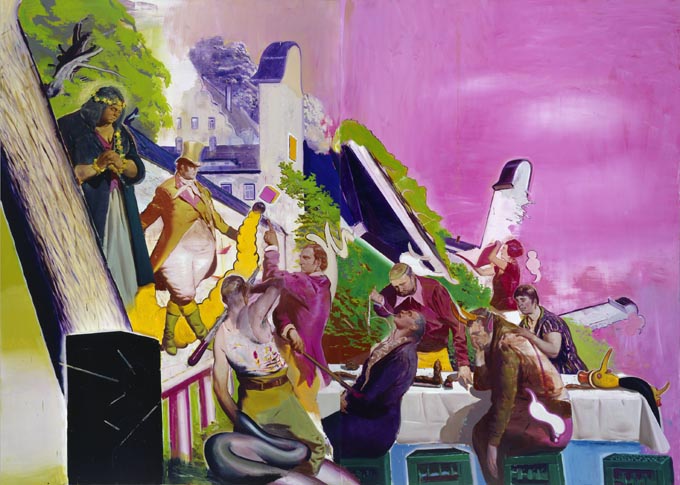Neo Rauch: "Begleiter" ("Companions")
Exhibit at the Pinakothek der Moderne, Munich, Germany: April 20-August 8, 2010.
Well, I am heading back to Los Angeles from Munich. Neo Rauch turned 50 in April, and he has a huge retrospective at the Pinakothek der Moderne in Munich, in conjunction with the Museum der bildenden Kunste in Leipzig, to celebrate his birthday.
I turned 50 a few years ago and had a catered party at my Brewery Arts Complex studio, surrounded by rust and a hundred or so friends. I drank and we wore strange hats from Afghanistan.
Neo, as in 'new', has a different edge in these gilded times of the 'Art Vorld.' There is the Leipziger Schule (School), or was there ever the Leipziger School? Some underlings here in Germany claim it is a mechanization of the American media in conjunction with American collectors to celebrate an artist hoisted atop the pedestal. The vaulting of the mysterious, cloistered East. In 1989, when the Wall came tumbling down, Rauch was 29 years old. Rauch has chosen to and continues to stay in the East (the former GDR).
When the dust lands, who and what is Neo Rauch?
If nothing else he is prolific. Arbeit (work) is woven into the fabric of the German and in particular the former East Germans under the hammer of Communism, which created an amalgam of the oppressed.
The Pinakothek der Moderne exhibit consists of 60 works, with an additional 60 or so works in Leipzig. In the Munich show there consists a selection from the last twenty years, mainly from private collections, created between 1993 until 2010.
The works are grandiose, cartooned or almost screened on in their flatness. They allude to gas station billboards that littered the US highways in the 1950s. Vaudeville black-faced posters, Thomas Edison, and a balloon of social realism drawn then colored in with faded colors of mass printed pulp, all congealed together, to present a series of stories, that present more stories, none of them to be figured out. Is this depth or confusion? To be defined, or not to be defined, because it transcends definition?
"Quality" will persist throughout time -- "quandary" may not.
The quality of this work is a blended pastiche, swirling through the horrors of the workers and the worked. It is not incidental that Neo Rauch works out of an old cotton mill, outside of Leipzig. He was trained at the Leipziger Hochschule für Grafik und Buchkunst (Higher Education for Graphic and Book Art). Both his studio locale and his studies strongly influence and inform his works. This might demystify some of his references and his own lack of verbal characterization of such pictorial notations.
There is a consistency to the work and a quality of its execution. Early works, 1993 through 1998 or so, are closer to the graphic and book art tones. The irreverence and the execution of the graphic billboard tones of these works are far less moving then his present work.
His monochromatic work took hold in "Das Blau" (2006), a construction made entirely of decentralized blues. A definitive standout and the first piece that is seen as you walk up the dramatic Moderne's steps is "Vorfuehrung" (2006) 
"Vorfuehrung," meaning projectionist or presentation, is a work carefully composed, loosely painted, and makes a very smart play of space. Magenta and the otherwise disturbing Veridian greens that Rauch loves to employ act in perfect discordance.
Throughout the work in and outside of this exhibit, color is employed to set emotional tones, and although often drab and depressing, he succeeds in his execution.
The WPA posters of the 1930's, late 18th century American paintings like that of John Singelton Copley, a note from the surrealists and others already mentioned, are just some of the innumerable hiccups in art history on which Neo Rauch likes to ruminate and hover.
One of his recent works, "Kalimuna" (2010), comprised of monochromatic acid greens connoting a carnival or a backlot of a movie set, carries on the drama of the absurd that strikes a cord in his best work.
My personal favorite is "Paranoia" (2007), a relatively demure piece (compared to the museum scale of his usual works) also dowsed with lemon greens. The entire room and figures depicted are bending towards a window covered with the brightest and most painful light green. It is pointed, amusing and of course disturbing.
Mr. Rauch is a master of the veil. A veil of history, of stories under other stories, and allusions over illusions. All the while there is a sinister undertone that bites and gnaws.
Credit: Artist Neo Rauch/Eigen+Art
http://cgi.eigen-art.com/user-cgi-bin/index.php?article_id=6&clang=0
Vorführung, 2006
Oil on linen
118 1/8 x 165 3/8 in. (300 x 420 cm)
Rubell Family Collection, Miami
Joshua Elias is an artist and writer living and working in Los Angeles
art@joshuaelias.com -- www.joshuaelias.com